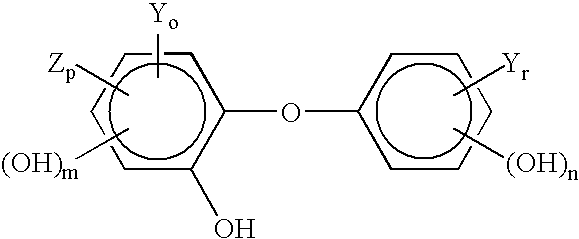Method of enhancing the control of viruses on skin
a technology of skin and virus, applied in the direction of biocide, hair cosmetics, synthetic polymeric active ingredients, etc., can solve the problems of high virus infection rate of all mammals, significantly reducing the population of microorganisms, including pathogens, and affecting the health of mammals, so as to reduce the transmission of virus-mediated diseases and conditions, reduce the number of virus populations, and quick control
- Summary
- Abstract
- Description
- Claims
- Application Information
AI Technical Summary
Benefits of technology
Problems solved by technology
Method used
Image
Examples
example 1
[0223] The standardization of skin pH attributed to a preconditioning step was demonstrated by applying Dial Complete, an antibacterial cleanser, to the skin. In one experiment, commercial Dial Complete (pH 5.8) was applied to the fingertips of a test subject (Test Subject 1). In a second experiment, Dial Complete adjusted to pH 3.8 was applied to the fingertips of a second test subject (Test Subject 2). In each test, a baseline skin pH was measured. Skin pH was measured again after the applied antibacterial cleanser dried on the skin. The results are summarized below.
Skin pH afterBaseline Skin pHPreconditioning StepTest subject 14.825.60Test subject 25.085.32
The skin pH data shows that for both preconditioning compositions, i.e., pH 3.8 and pH 5.8, the skin pH was standardized to 5.3 to 5.6. In addition, the skin was cleansed of soil and sebum. Although skin pH was raised after this preconditioning step, the skin pH remained a pH unit less than 6.5, and, therefore, conditioned t...
example 2
[0224] The following antiviral compositions first were prepared.
IngredientComposition A1)Composition BEthyl alcohol62% 62% L-Malic acid2%2%Citric acid2%2%ULTREZ 202)1%—NATROSOL 250 HHX3)—1%Waterq.s.q.s.pH3.53.5
1)Percent by weight, as active ingredient;
2)Acrylates C20-30 Alkyl Acrylate Crosspolymer; and
3)hydroxyethylcellulose.
[0225] In this example, three milliliters of antiviral Composition A or B was applied to cover the hands of test subjects. In one group, the hands were preconditioned using a preconditioning composition. In a second group, the antiviral composition was applied to “unconditioned” hands. The composition used in the preconditioning step was a commercially available, mild baby soap containing cocamidopropyl betaine, PEG-80 sorbitan laurate, sodium lauryl sulfate, PEG-150 distearate, tetrasodium EDTA, sodium chloride, polyquatemium-10, quatemium-15, citric acid, fragrance, and water, had a pH of between 6 and 7. The test subjects were allowed to use their hands ...
example 3
[0226] The following table shows that the initial skin pH of the hands was reduced using Compositions A and B following a preconditioning step with the neutral preconditioning composition of Example 2. Reducing skin pH has been shown to increase antiviral efficacy against rhinovirus. Two pumps, or about one to about two liquid ounces, of the preconditioning composition from a container was dispensed into the wet palms of a test subject. The hands were rubbed together in a normal hand-washing motion for 15 seconds, then the hands were rinsed for 30 seconds under warm water. An antiviral Composition A or B then was dispensed onto the hands in metered doses (about one ounce) and rubbed onto the hands.
Normal Use (no conditioning wash)Composition BComposition AStarting pHStarting pHStarting pHStarring pHTimeNo ConditioningConditionedNo ConditioningConditioned3 hrs.3.383.283.273.04
PUM
| Property | Measurement | Unit |
|---|---|---|
| Temperature | aaaaa | aaaaa |
| Fraction | aaaaa | aaaaa |
| Fraction | aaaaa | aaaaa |
Abstract
Description
Claims
Application Information
 Login to View More
Login to View More - R&D
- Intellectual Property
- Life Sciences
- Materials
- Tech Scout
- Unparalleled Data Quality
- Higher Quality Content
- 60% Fewer Hallucinations
Browse by: Latest US Patents, China's latest patents, Technical Efficacy Thesaurus, Application Domain, Technology Topic, Popular Technical Reports.
© 2025 PatSnap. All rights reserved.Legal|Privacy policy|Modern Slavery Act Transparency Statement|Sitemap|About US| Contact US: help@patsnap.com



